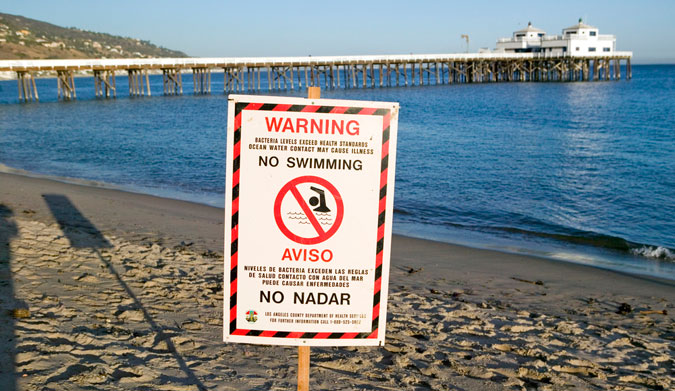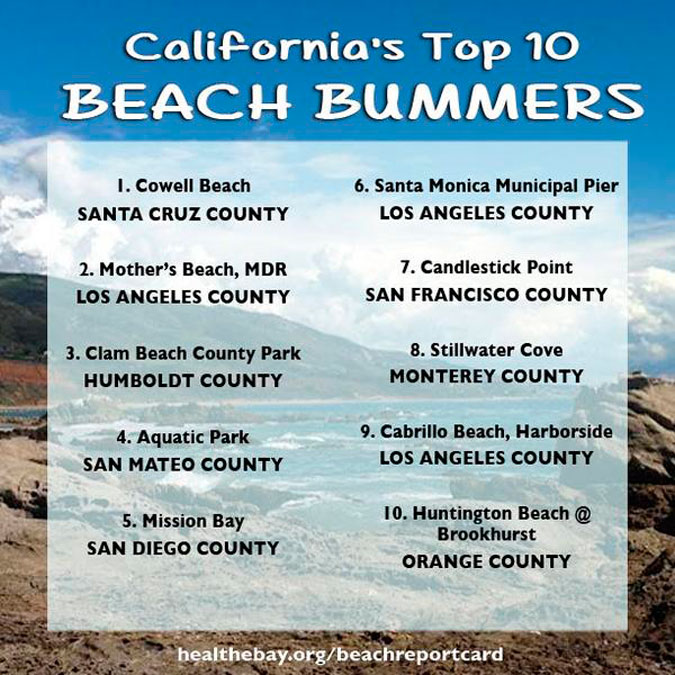
Did your beach make the grade? Photo: Shutterstock
School’s out for summer… but the grades are in for California’s beaches. Californians heading to the beach this summer will be heartened by continued excellent water quality, according to Heal the Bay’s 25th annual Beach Report Card.
Heal the Bay scientists released a report this week assigning A-to-F grades based on levels of weekly bacterial pollution for 468 beaches along the California coast. Roughly 95% of beaches received A or B grades during the summer (April-October 2014), which is on par with grades the previous year.
Overall, only 13 of the beaches monitored statewide received D to F grades during summer dry weather, when most beachgoers typically use the ocean. High bacteria counts at these sites are linked to potential illnesses like stomach flu, ear and upper respiratory infections, and skin rashes.
The severe drought now impacting California appears to be a major contributing factor to generally strong water quality at beaches statewide. With record low rainfall reducing the amount of polluted runoff funneled to our coast, beach grades across the state are consistently outperforming their five-year average. Although water quality grades may be higher with less runoff, we need to be prepared for stormier times and avoid a false sense of security about these water quality improvements. California often swings from extended dry periods to shorter periods of intense, wet weather. We need to rethink runoff and turn this nuisance into a resource–our local water supplies could be greatly supplemented by capturing, cleansing, and reusing runoff instead of sending it out to sea.
We are fortunate enough to live in a state where you can surf, swim, and dive year-round. Unfortunately, when it did rain over the last year, beach water quality plummeted, with only 63% of California beaches receiving As or Bs. And nearly one in four beaches monitored during wet weather earned F grades. This dramatic seasonal difference in water quality between dry and wet weather is why Heal the Bay and California public health agencies continue to recommend that people avoid the water for at least three days after a significant rainstorm. As a surfer, I know this can be a challenge, as some of the best swells accompany storms. But, it’s not just an active lifestyle that’s beneficial to public health, it’s also important that people carefully choose to exercise and recreate in places that are clean and safe.
Heal the Bay’s Beach Bummer List, a ranking of the state’s 10 most polluted beaches, is evenly split among beaches in Southern and Northern California. Cowell Beach in Santa Cruz has the dubious distinction of topping the list for a second year in a row. New entrants this year include Mission Bay at Clairmont Drive in San Diego, Candlestick Point/Sunnydale Cove in San Francisco and Huntington State Beach at Brookhurst in Orange County.

It’s not all bad news. Some 19 beaches in the state were named to Heal the Bay’s Honor Roll, meaning they were monitored year-round and scored perfect A+ grades every week of the year, regardless of dry or rainy conditions.
For full results, please visit Heal the Bay’s website to read the report and visit www.beachreportcard.org for weekly beach grades.
See more from Heal the Bay on their website, like them on Facebook, and follow them on Instagram.

